By Chris Kouns
USSF A License (USSF Coaching Education Instructor) – NSCAA Premier Diploma (NSCAA Coaching Education Associate Staff Coach) – Head Women’s Soccer Coach – Georgia Gwinnett College
This session will offer potential combinations for the #6, #8, #7, #11, #2 AND #3 players to use in order to create attacking opportunities.
Initial Introduction of Movements and Warm-Up
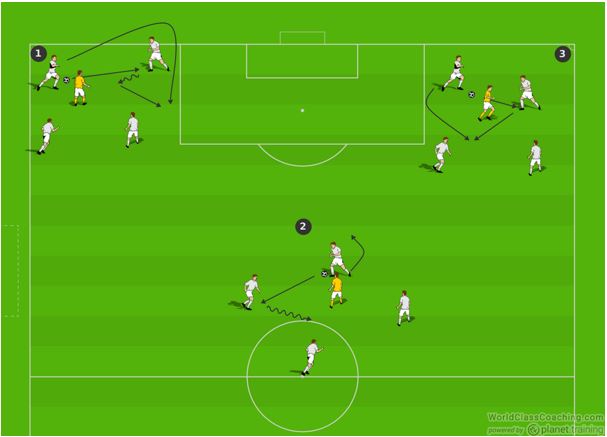
Set-Up
Players will be split into groups of five with a ball for each group. There will be one defending player and four players looking to keep possession of the ball without allowing the defender to touch it.
Execution
The players keeping possession of the ball must keep it while executing the following restrictions:
- Following every pass the passer must overlap the player who received the ball.
- Following every pass the passer must backpedal three steps and then must re-position themselves to be an option for the ball.
- At least once every five passes the players in possession must complete a wall pass or give and go to maintain possession.
Coaching Points
- The player on the ball should work to receive it so that they are always facing their teammates. This would allow them the most options with the ball.
- The player receiving the ball should take a diagonal first touch towards the area the ball came from to open up the space and opportunity for combination play.
- The player on the ball should use the following visual cues for their decision making: If the defender steps with the ball play the overlapping player. If the defender cheats to the overlapping player then the player on the ball should keep it and dribble.
- The player who played the ball and is overlapping should do so at full pace to maximize the pressure of decision the defender must make on who to take (ball or man).
- The player who played the ball and is backpedaling should drift in the backpedal diagonally away from the direction they played the ball so the defender cannot easily choose which option to take.
- The player who is received the ball should look at the body position of the defender to go at them if they are dropping or pass around them if they are stationary.
- The player that plays the ball and then is moving for a wall pass option must make their run so that they are even with the defender and can easily play a ball in behind breaking their pressure.
Variations
You can restrict the players in this activity to a grid (suggested size 15 x 15) or you can allow them to use free flowing space and simply encourage them not to get too spread out so it becomes too easy to keep possession.
You can also reward the defender, and make it harder for the group in possession, by allowing the defender to change on a touch on the ball, a ball forced out of the grid or a ball they win.
Part 2
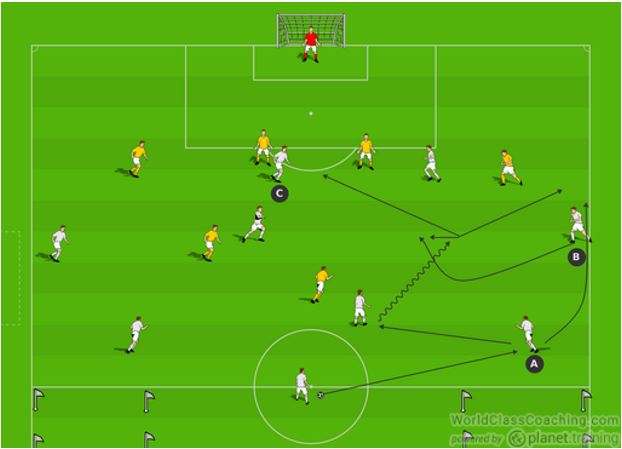
Setup
On a half field there will be two teams with one in a 3-4-2 formation and the other in a 2-4-1 formation. The 3-4-2 team will be going to a big goal while the 2-4-1 team will be attacking counter attack areas above midfield.
Execution
The ball always begins with the three defenders in the 3-4-2. They are required to play the ball to a midfielder for the activity to begin. Once the midfielder touches the ball their team is live to goal.
When the 2-4-1 team wins the ball, in the flow of play or from the goal keeper then they are looking to spring forward and get the ball into the counter attack area.
Variations
You can increase the five to a bank of seven which will give them more vertical pressure. That would mean adding a #9 and #4 to the double pivot and attacking trio.
Coaching Points
- The #6 player should work to make themselves the easiest option for the defenders by checking into the vacant areas of the midfield allowed by having just two opposing players.
- The #8 player should assume a position that is visible to the defenders, however, is opposite of the position the #6 is taking. This should offer both a long and short midfield option for the defender.
- Both the #6 and the #8 should receive the ball side on and facing forward so they can attack and find options in as little time as possible.
- The #7 and #11 players should work to maintain as much width as possible but recognize the visual cue that their position should make a triangle between the striker closest to them and the #6 player.
- Both the #7 and #11 player should recognize they must work up the line and back down the line as those two players move within the confines of the field.
- When the #7 and #11 players get the ball they must recognize the two options available to them which is to bring the ball diagonally towards the post (dribble or pass) or bring the ball down the line (dribble or pass)
- The #2 and #3 players will begin in a position that offer closer support to the one central defender, however, they are looking for opportunities to join the attack with the wide midfielder on their side and move up the field as an attacking unit.
- The #2 and #3 must be aware of their options and constantly be moving in a manner that allows them to form passing angles (triangles) with the #6 player and the wide midfielder on their side.
- The #9 and #10 players should focus on a high starting position to stretch the defenders and offer themselves as constantly available tips of the passing triangles.
Options That May Become Available
- A) OVERLAPPING #2 OR #3
- B) OVERLAPPING OR WALL PASS #7 OR #11
- C) DRIFTING AND SLASHING #9 OR #10
Variations
The defenders in the 3-4-2 can play a ball directly to one of the twin strikers if that option is available.
The ball can begin from throw ins with the defenders and midfielders starting their attack off a pass restart.
Part 3
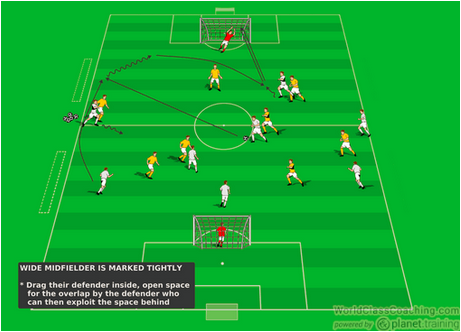
Setup
9 v 9 including Goal Keepers: The two teams will play in an area from the top of the 18 yard boxes. There will be a full sized goal at the top of each box with a keeper in play.
Execution
Both teams will be aligned in a 1-3-4-1 formation. The back line should consist of a #2, #4 and #3. The Midfield should include a #7, #6, #8 and #11. The lone player up top should be represented by a #9. There will be three phases of the activity that will be run for a 15 minute duration. Each phase will have a distinct focus for the teams to emphasize in order to involve their backs and midfielders in breaking the defensive line of the opposing team.
Time Phase One
The main area of focus for this period will be to have the two teams value the ball through a compact structure. Their proximity in terms of compactness should allow the interjection of defenders into the attacking third. This interjection should be completed through combinations between the #2 & #3 with their accompanying #7 & #11.
** See two diagrams that script out possible combination opportunities
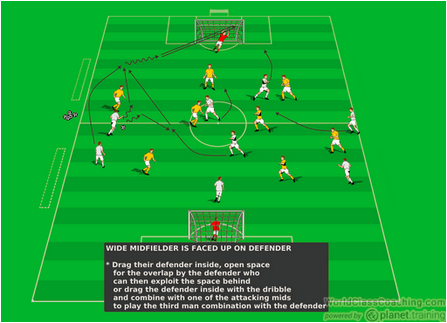
Coaching Points
The #2 and #3 players must be acutely aware of the body positioning of the #7 or #11 in front of them. Should the body position cut off the sideline then their avenue for joining would be cut off. However, if the body position is open to the field and creating a crease then they should mentally prepare to join forward.
The #7 and #11 players must work to receive balls facing forward or at a minimum towards the far post. In addition their first touch should come in at an angle towards one of the posts of the goal they are attacking so they will open the door for the back to join.
The #9 player and the #8 player can assist the inclusion of the #2 or #3 by dragging their defenders away from the space that the defender wants to exploit. They must avoid the natural instinct to come to the ball as that would bring more defenders into the area.
The #6 and #8 players must be aware of their opportunities to break the back line with a third man running combination to the #2 or #3.
Timed Phase Two
The main area of focus for this period will be to have the two teams pay special attention to the entry passes they are giving to the midfielders. In order for the midfielders to easily eliminate lines of pressure they must have balls that will allow them to play in the gaps to both the near side and far side wide midfielders. This will require acute awareness of the parts of the field susceptible to being broken by a pass from the #6 or #8 players.
** See diagram offering potential options for this coordinated attack
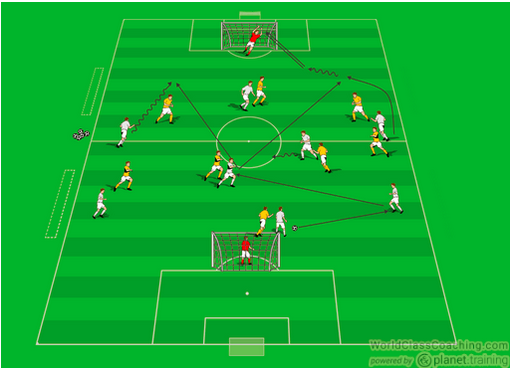
Coaching Points
The entry pass into the center of the midfield should arrive at the #6 or the #8 in a position where they would be capable of hitting a one-time ball to the diagonal runs of the #7 and #11. It must not be behind them and must also have the proper pace for redirection before a defender closes them down in the center of the park.
The #7 and #11 players must maintain their width and not attempt to break the line with their runs until the space has been made available for them. The patience to stay long enough to allow the #9 or the other attacking mid to move the central defenders and open those gaps that can be exploited is vital.
To help offset the defensive focus the opposite side wide midfielder may decide to go at the same time as the near side midfielder forcing the defenders to make a quick decision on the greatest threat. This is predicated by the body position of the #6 and #8 when they get the ball and their ability to play the right textured ball into the path of either player.
The recognition of visual cue to break the line is for the #7 and #11 player to watch the head of the defenders. When their head turns to focus on the midfielder with the ball that is their cue to get in on the blind side.
Timed Phase Three
In this period each team will have a designated method they are looking to train for breaking the lines of defense they are facing. One of the teams should look to break the defensive units by utilizing their wide defenders in the appropriate time and manner. The other team should look to break the defensive blocks mainly utilizing the movement of the midfielders. *Please note this does not mean that a team cannot break through with a player that is not their focus that time period, but, that the majority of teachable moments should focus on that block of players.
By Chris Kouns: USSF A License (USSF Coaching Education Instructor) – NSCAA Premier Diploma (NSCAA Coaching Education Associate Staff Coach) – Head Coach Georgia Gwinnet College Women’s Soccer (GA)


